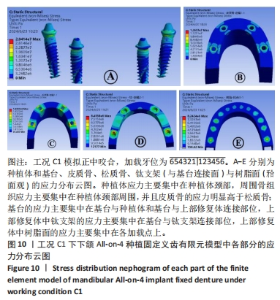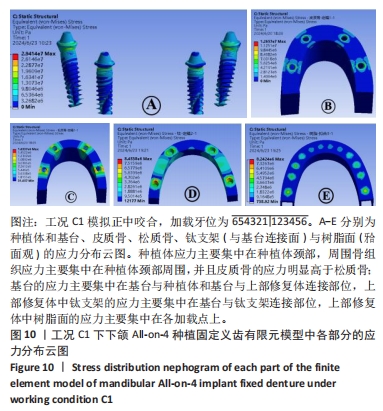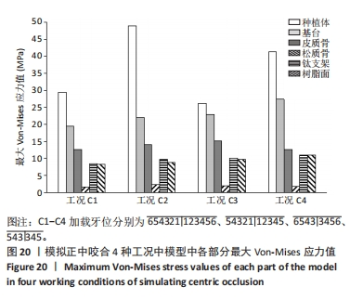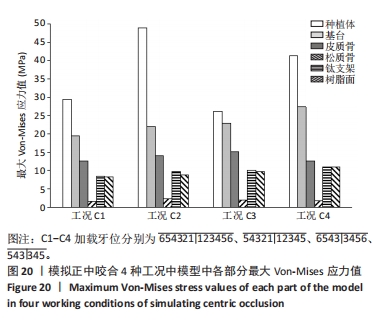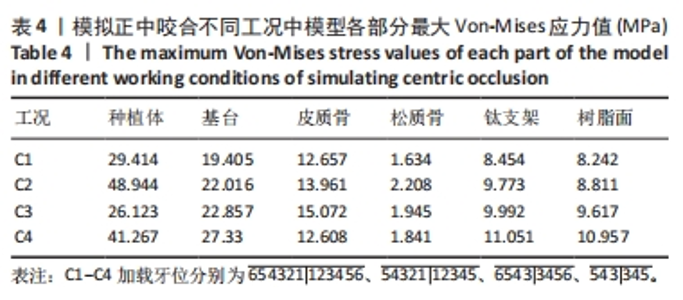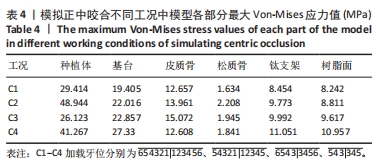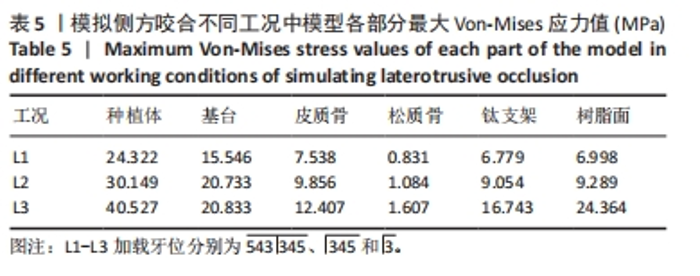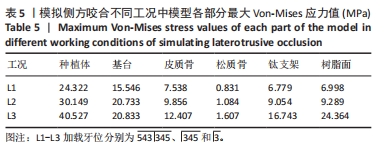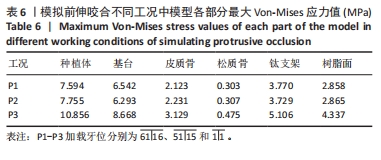Chinese Journal of Tissue Engineering Research ›› 2025, Vol. 29 ›› Issue (28): 6020-6029.doi: 10.12307/2025.480
Previous Articles Next Articles
Finite element analysis of stress distribution on mandibular All-on-4 implant fixed denture with different occlusion
Wu Zhengmin1, Li Changxu1, Cui Yanwei1, Chen Su2
- 1Department of Stomatology, Beijing Friendship Hospital, Capital Medical University, Beijing 100050, China; 2VIP Department, School of Stomatology, Capital Medical University, Beijing 100050, China
-
Received:2024-05-11Accepted:2024-08-14Online:2025-10-08Published:2024-12-07 -
Contact:Chen Su, Professor, Chief physician, Doctoral supervisor, VIP Department, School of Stomatology, Capital Medical University, Beijing 100050, China -
About author:Wu Zhengmin, MS, Attending physician, Department of Stomatology, Beijing Friendship Hospital, Capital Medical University, Beijing 100050, China
CLC Number:
Cite this article
Wu Zhengmin, Li Changxu, Cui Yanwei, Chen Su. Finite element analysis of stress distribution on mandibular All-on-4 implant fixed denture with different occlusion[J]. Chinese Journal of Tissue Engineering Research, 2025, 29(28): 6020-6029.
share this article
Add to citation manager EndNote|Reference Manager|ProCite|BibTeX|RefWorks
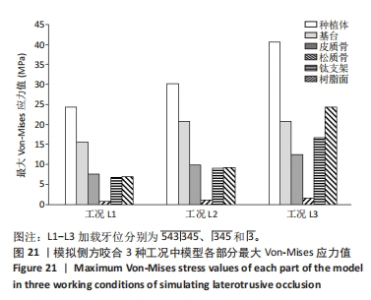
分析比较模拟正中咬合各种工况中种植体、基台、皮质骨、松质骨及上部修复体中钛支架和树脂面的最大Von-Mises应力值可以得出:末端悬壁区不加力时种植体最大Von-Mises应力值较加力时明显增大,工况C2中种植体最大Von-Mises应力值较工况C1增大66.40%,工况C4中种植体最大应力值较工况C3增大57.97%;前牙区不加力时种植体最大Von-Mises应力值较加力时减小,基台最大Von-Mises应力值较加力时增大,两者变化幅度相当,其余部分变化不明显;模拟正中咬合工况C3中模型各部分应力分布相对更均匀。 2.2.2 模拟侧方咬合3种工况中模型各部分最大Von-Mises应力值 见图21,表5。"
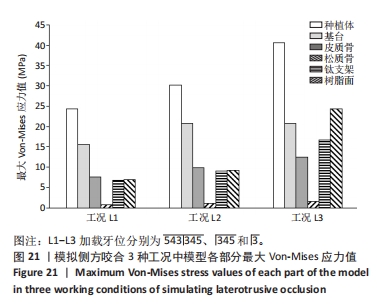
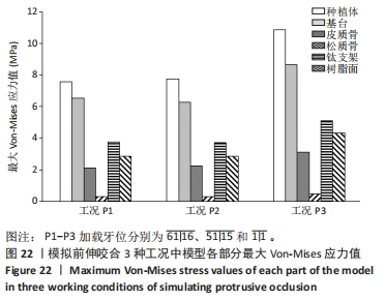
分析比较模拟侧方咬合各种工况中种植体、基台、皮质骨、松质骨及上部修复体中钛支架和树脂面的最大Von-Mises应力值可以得出:模拟尖牙保护牙合的工况L3中种植体、皮质骨和上部修复体的最大Von-Mises应力值明显增大,种植体最大Von-Mises应力值较工况L2增大34.42%,皮质骨最大Von-Mises应力值较工况L2增大25.88%,钛支架最大Von-Mises应力值较工况 L2增大84.92%,树脂面最大Von-Mises应力值较工况 L2增大162.29%,上部修复体最大Von-Mises应力增大更明显;与模拟平衡牙合的工况L1比较,模拟组牙功能牙合的工况L2中模型各部分最大Von-Mises应力值略有增加。 2.2.3 模拟前伸咬合3种工况中模型各部分最大Von-Mises应力值 见图22,表6所示。"
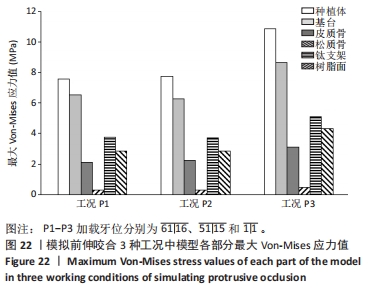

分析比较模拟前伸咬合各种工况中种植体、基台、皮质骨、松质骨及上部修复体中钛支架和树脂面的最大Von-Mises应力值可以得出:工况P3中模型各部分最大Von-Mises应力值较工况P1、P2均明显增大,种植体最大Von-Mises应力值较工况 P2增大39.99%,基台最大应力值较工况P2增大37.74%,皮质骨最大Von-Mises应力值较工况P2增大40.25%,松质骨最大Von-Mises应力值较工况P2增大54.72%,钛支架最大Von-Mises应力值较工况P2增大36.93%,树脂面最大Von-Mises应力值较工况P2增大51.38%;模拟平衡牙合的工况P1和P2比较,后牙区加载点在悬臂区和在悬壁区前方时模型各部分最大Von-Mises应力值变化不明显。"

| [1] OH SH, KIM Y, PARK JY, et al. Comparison of fixed implant-supported prostheses, removable implant supported prostheses, and complete dentures: patient satisfaction and oral health-related quality of life. Clin Oral Implants Res. 2016;27(2):e31-e37. [2] YAO CJ, CAO C, BORNSTEIN MM, et al. Patient-reported outcome measures of edentulous patients restored with implant-supported removable and fixed prostheses: A systematic review. Clin Oral Implants Res. 2018;29 Suppl 16:241-254. [3] REISSMANN DR, DARD M, LAMPRECHT R, et al. Oral health-related quality of life in subjects with implant-supported prostheses: A systematic review. J Dent. 2017;65:22-40. [4] ELSYAD MA, ELGAMAL M, MOHAMMED ASKAR O, et al. Patient satisfaction and oral health-related quality of life (OHRQoL) of conventional denture, fixed prosthesis and milled bar overdenture for All-on-4 implant rehabilitation. A crossover study. Clin Oral Implants Res. 2019;30(11):1107-1117. [5] MALÓ P, RANGERT B, NOBRE M. “All-on-Four” immediate-function concept with Branemark System implants for completely edentulous mandibles: a retrospective clinical study. Clin Implant Dent Relat Res. 2003;5 Suppl 1:2-9. [6] CHAN MH, NUDELL YA. All-on-4 Concept Update. Dent Clin North Am. 2021;65(1):211-227. [7] GRANDI T, SIGNORINI L. Rehabilitation of the completely edentulous mandible by all-on-four treatment concept: a retrospective cohort study with up to 10 years follow-up. Medicina (Kaunas). 2021;58(1):10. [8] 陆婧,李英,孟茂花,等.三维有限元方法分析“All-on-4”技术的生物力学特征[J].中国组织工程研究,2024,28(22):3591-3596. [9] 张海萍,许天民,林久祥.β函数拟合正常(牙合)牙弓形态的研究[J].口腔正畸学,2005,12(1):19-23. [10] TAKAHASHI T, SHIMAMURA I, SAKURAI K.Influence of number and inclination angle of implants on stress distribution in mandibular cortical bone with All-on-4 Concept. J Prosthodont Res. 2010;54(4): 179-184. [11] 王璨,顾卫平,蒋煜彬,等.不同种植设计对下颌无牙颌应力影响的有限元分析[J].中国组织工程研究,2022,26(4):573-578. [12] HAROUN F, OZAN O. Evaluation of Stresses on Implant, Bone, and Restorative Materials Caused by Different Opposing Arch Materials in Hybrid Prosthetic Restorations Using the All-on-4 Technique. Materials (Basel). 2021;14(15):4308. [13] 王煜婷,张少锋,董岩,等.All-on-4种植体参数对周围骨应力影响的三维有限元分析[J].实用口腔医学杂志,2014,30(2):193-197. [14] 温颖,郑东翔,张振庭,等.全口无牙颌应用种植固定修复后的咬合力分布研究[J].北京口腔医学,2008,16(6):325-328. [15] 王琰玲,殷新民.不同侧方(牙合)型者尖对尖颌位时相对(牙合)力的比较研究[J].口腔医学,2009,29(9):476-478. [16] 王惠芸.我国人牙的测量和统计[J].中华口腔科杂志,1959,7(3): 149-155. [17] 皮昕.口腔解剖生理学[M].6版.北京:人民卫生出版社,2007: 288-289. [18] DO TA, LE HS, SHEN YW, et al. Risk factors related to late failure of dental implant-a systematic review of recent studies. Int J Environ Res Public Health. 2020;17(11):3931. [19] SZABÓ ÁL, NAGY ÁL, LÁSZLÓFY C, et al. Distally tilted implants according to the all-on-four® treatment concept for the rehabilitation of complete edentulism: a 3.5-year retrospective radiographic study of clinical outcomes and marginal bone level changes. Dent J (Basel). 2022;10(5):82. [20] BOZYEL D, TAŞAR FARUK S. Biomechanical behavior of All-on-4 and M-4 configurations in an atrophic maxilla: a 3D finite element method. Med Sci Monit. 2021;27:e929908. [21] PANDEY C, ROKAYA D, BHATTARAI BP. Contemporary Concepts in Osseointegration of Dental Implants: A Review. Biomed Res Int. 2022; 2022:6170452. [22] TURKER N, BUYUKKAPLAN US, SADOWSKY SJ, et al. Finite element stress analysis of applied forces to implants and supporting tissues using the “All-on-Four” concept with different occlusal schemes. J Prosthodont. 2019;28(2):185-194. [23] KIM Y, OH TJ, MISCH CE, et al. Occlusal considerations in implant therapy:clinical guidelines with biomechanical rationale. Clin Oral Implants Res. 2005;16(1):26-35. [24] ABDUO J, TENNANT M. Impact of lateral occlusion schemes:a systematic review. J Prosthet Dent. 2015;114(2):193-204. [25] MIRALLES R. Canine-guide occlusion and group function occlusion are equally acceptable when restoring the dentition. J Evid Based Dent Pract. 2016;16(1):41-43. [26] TURKER N, ALKIS HT, SADOWSKY SJ, et al. Effects of occlusal scheme on all-on-four abutments, screws, and prostheses: a three-dimensional finite element study. J Oral Implantol. 2021;47(1):18-24. [27] 王佐林,范震.无牙颌种植修复设计[J].口腔颌面外科杂志,2013, 23(1):1-7. [28] 李晓茜,马晓妮,徐欣.无牙颌种植固定修复的咬合分析[J].华西口腔医学杂志,2018,36(6):628-63229 [29] 马斐斐,林野,邸萍,等.T-Scan Ⅲ咬合分析系统测量无牙颌All-on-4种植修复后力分布初探[J].中华口腔医学杂志,2016,51(9): 517-520. [30] 庞丽娇,杨海萍,胡婷姿,等.All-on-4种植固定修复的咬合设计[J].口腔医学,2021,41(8):765-768. [31] 木志翔,刘婷,陈陶,等.两种上颌无牙颌种植固定修复方案的有限元分析[J].口腔医学研究,2019,35(10):931-935. [32] STOICHKOV B, KIROV D. Analysis of the causes of dental implant fracture: a retrospective clinical study. Quintessence Int. 2018;49(4): 279-286. [33] SHETTY R, SINGH I, SUMAYLI HA, et al. Effect of prosthetic framework material, can lever length and opposing arch on peri-implant strain in an all-on-four implant prostheses. Niger J Clin Pract. 2021;24(6):866-873. [34] GREENSTEIN G, CAVALLARO J JR. Cantilevers extending from unilateral implant-supported fixed prostheses: a review of the literature and presentation of practical guidelines. J Am Dent Assoc. 2010;141(10):1221-1230. [35] DRAGO C. Ratios of cantilever lengths and anterior-posterior spreads of definitive hybrid full-arch, screw-retained prostheses: results of a clinical study. J Prosthodont. 2018;27(5):402-408. [36] GOMES LCL, PIERRE FZ, TRIBST JPM, et al. Occlusal scheme effect on the biomechanical response of full-arch dental prosthesis supported by titanium implants: A systematic review. Metals. 2021;11:1574. [37] BOZYEL D, TAAR FARUK S. Biomechanical behavior of All-on-4 and M-4 configurations in an Atrophic Maxilla: A 3D Finite Element Method. Med Sci Monit. 2021;27:e929908. [38] MOHAMED AMA, ASKAR MG, El HOMOSSANY MEB. Stresses induced by one piece and two piece dental implants in All-on-4® implant supported prosthesis under simulated lateral occlusal loading: non linear finite element analysis study. BMC Oral Health. 2022;22(1):196. [39] WANG Q, ZHANG ZZ, BAI SZ, et al. Biomechanical analysis of stress around the tilted implants with different cantilever lengths in all-on-4 concept. BMC Oral Health. 2022;22(1):469. [40] SEZER T, KILIC K, ESIM E. Effect of implant diameter and bruxism on biomechanical performance in maxillary All-on-4 treatment: A 3D finite element analysis. Int J Oral Maxillofac Implants. 2022;37(4):709-721. |
| [1] | Xu Hao, Ding Lu, Li Xiao. Investigating the effect of the mechanical wear on abutment screw in Morse taper connection implant implant system by using finite element analysis [J]. Chinese Journal of Tissue Engineering Research, 2025, 29(在线): 1-9. |
| [2] | Li Liangkui, Huang Yongcan, Wang Peng, Yu Binsheng. Effect of anterior controllable anteriodisplacement and fusion on vertebrae-ossification of posterior longitudinal ligament complex and implants: a finite element analysis [J]. Chinese Journal of Tissue Engineering Research, 2025, 29(9): 1761-1767. |
| [3] | Xu Biao, Lu Tan, Jiang Yaqiong, Yin Yujiao. Xu Biao, Lu Tan, Jiang Yaqiong, Yin Yujiao [J]. Chinese Journal of Tissue Engineering Research, 2025, 29(9): 1768-1774. |
| [4] | Zhou Jinhai, Li Jiangwei, Wang Xuquan, Zhuang Ying, Zhao Ying, Yang Yuyong, Wang Jiajia, Yang Yang, Zhou Shilian. Three-dimensional finite element analysis of anterior femoral notching during total knee arthroplasty at different bone strengths [J]. Chinese Journal of Tissue Engineering Research, 2025, 29(9): 1775-1782. |
| [5] | Chen Xi, Tang Tao, Chen Tongbing, Li Qing, Zhang Wen. Mechanical stability of intertrochanteric fracture of femur with different internal fixation systems [J]. Chinese Journal of Tissue Engineering Research, 2025, 29(9): 1783-1788. |
| [6] | Cai Yaohao, Lang Lyu, Li Hong. Assessing the bone mass of the residual alveolar ridge in the first molar for implant placement by cone-beam computed tomography [J]. Chinese Journal of Tissue Engineering Research, 2025, 29(8): 1572-1577. |
| [7] | Li Shuai, Liu Hua, Shang Yonghui, Liu Yicong, Zhao Qihang, Liu Wen. Stress distribution on the maxilla when wearing the Twin-block appliance for Class II malocclusion [J]. Chinese Journal of Tissue Engineering Research, 2025, 29(5): 881-887. |
| [8] | Zhou Zonghao, Luo Siyang, Chen Jiawen, Chen Guangneng, Feng Hongchao. Finite element analysis of bioabsorbable plates versus miniature titanium plates in mandibular fracture fixation in different bone qualities [J]. Chinese Journal of Tissue Engineering Research, 2025, 29(4): 818-826. |
| [9] | Chen Yilong, Zhang Xu, Li Hong. Mechanical analysis of fiber post combined with different crown restorations for endodontically treated non-carious cervical lesions [J]. Chinese Journal of Tissue Engineering Research, 2025, 29(4): 866-871. |
| [10] | Li Ruotong, Wu Yuening, Deng Yunyi, Chen Shichao, Lan Xiaorong, Li Shiting, Li Guangwen. Preparation and antibacterial evaluation of nanosilver-reduced graphene oxide/polydopamine/methacrylated gelatin@Gap19 hydrogel [J]. Chinese Journal of Tissue Engineering Research, 2025, 29(34): 7333-7343. |
| [11] | Zhuang Yan, Wang Xinyu, Cao Yilin, Ding Yuanxin, Wang Jiaqi, Yu Miao, Luan Chunyang, Ding Yuansheng. Three-dimensional finite element analysis of personalized orthodontic devices for 3D printed maxillary single-rooted rotated tooth [J]. Chinese Journal of Tissue Engineering Research, 2025, 29(30): 6409-6415. |
| [12] | Akliya·Anwar, Nafisa·Gupur, Baibugafu·Yelisi, Zilalai·Gulaiti, Guzalnur·Emrayim, Nijat·Tursun. Dynamic stress analysis of maxillary sinus lifting without bone grafting and with immediate loading after bone grafting [J]. Chinese Journal of Tissue Engineering Research, 2025, 29(30): 6416-6425. |
| [13] | Su Dejun, Dong Wanpeng, Dong Yuefu, Zhang Jichao, Zhang Zhen. Design of asymmetric prosthesis and mechanical analysis of total knee arthroplasty [J]. Chinese Journal of Tissue Engineering Research, 2025, 29(3): 510-516. |
| [14] | Wang X, Wang Hm, Chen Sh, Feng Tx, Bu Hm, Zhu Lg, Chen Dd, Wei X. Stress and morphological characteristics of intervertebral foramen of cervical rotation-traction manipulation for treating cervical spondylotic radiculopathy: a three-dimensional finite element analysis [J]. Chinese Journal of Tissue Engineering Research, 2025, 29(3): 441-447. |
| [15] | Zhao Yuxin, Liang Liang, Jin Feng, Xu Yangyang, Kang Zhijie, Fang Yuan, He Yujie, Wang Xing, Wang Haiyan, Li Xiaohe. Establishment and stress analysis of a finite element model for adolescent cervical disc herniation [J]. Chinese Journal of Tissue Engineering Research, 2025, 29(3): 448-454. |
| Viewed | ||||||
|
Full text |
|
|||||
|
Abstract |
|
|||||
